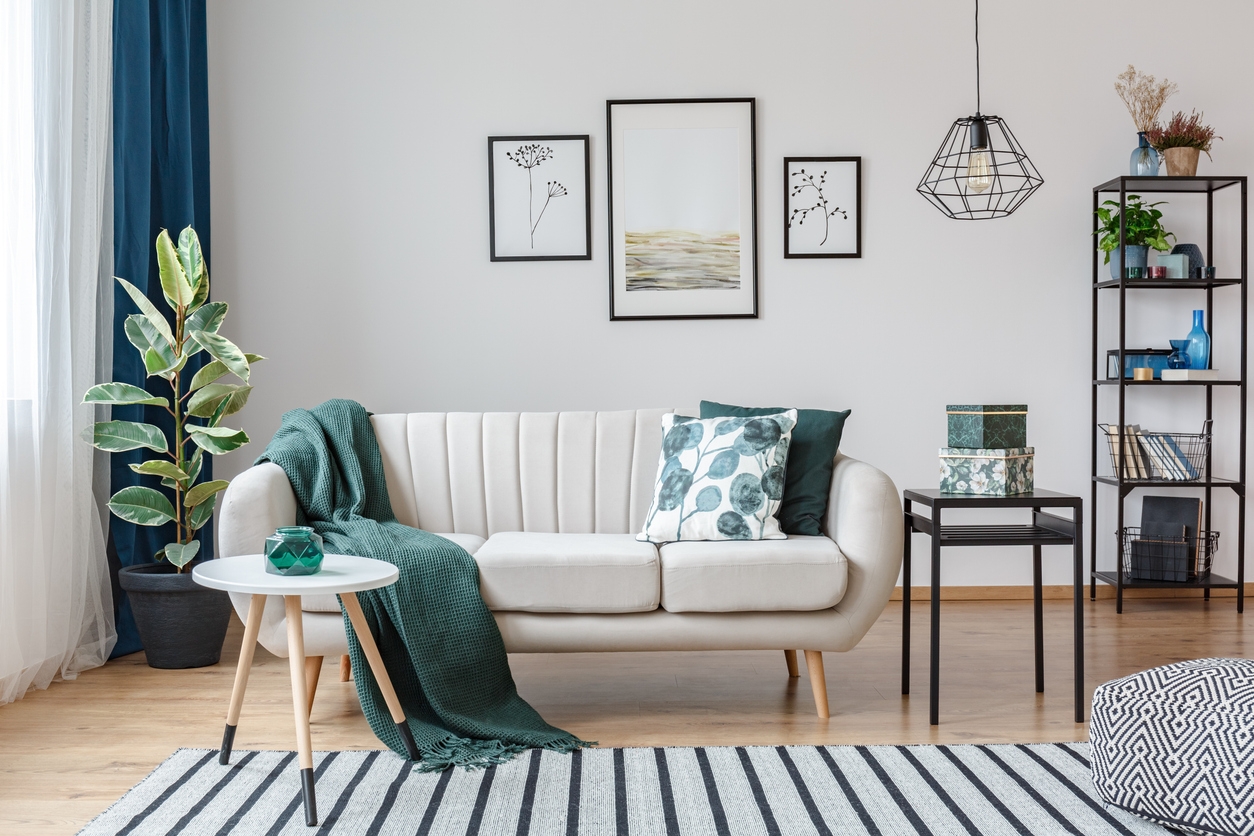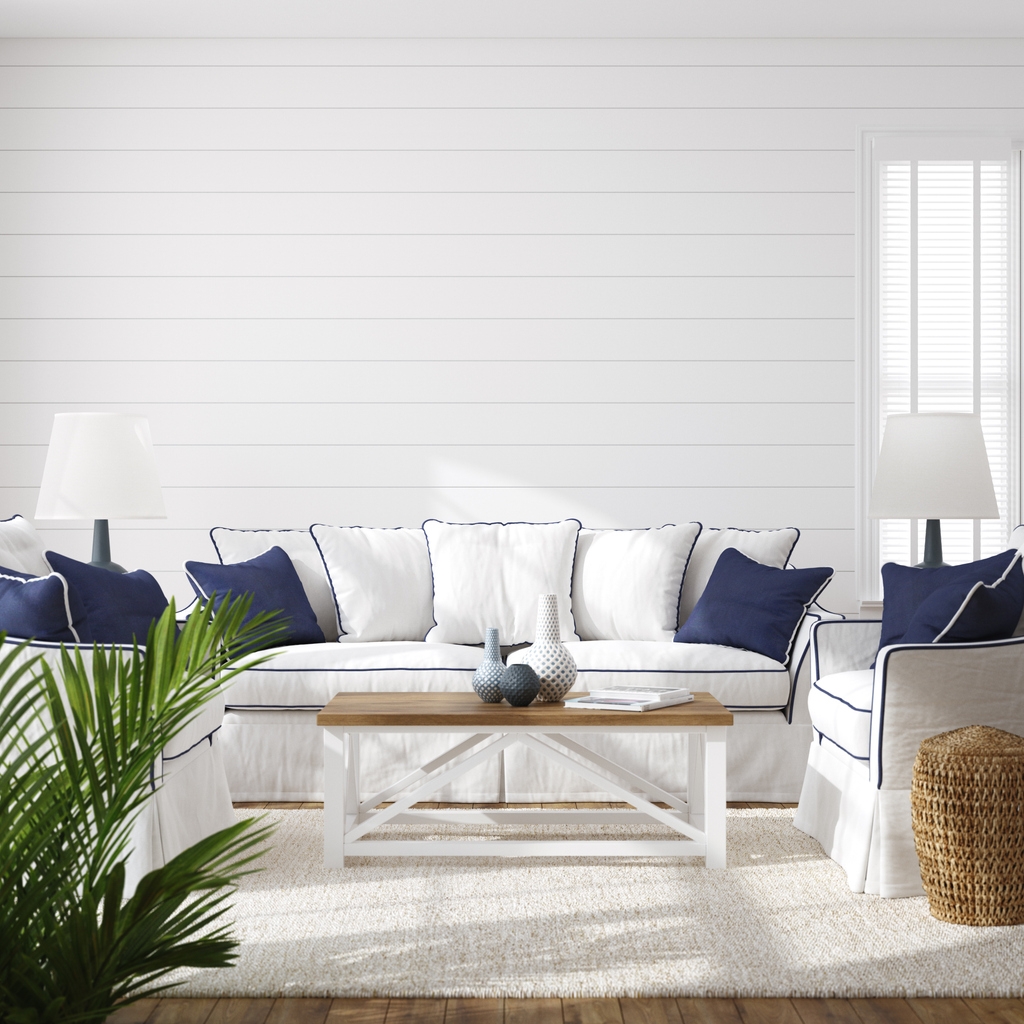A white living room offers a clean, modern, and versatile canvas, making it an ideal backdrop for any home. Its neutral tone provides a sense of openness and tranquility, but too much white can sometimes feel stark or uninspired. Adding splashes of color is essential to bring warmth, personality, and vibrancy to the space. Avoid costly mistakes and achieve cohesive décor—schedule our color consulting for painting session now.
Choosing a Color Palette
Selecting the right color palette is crucial in transforming your white living room from plain to captivating. The right colors can enhance the room’s aesthetics, create a harmonious atmosphere, and reflect your personal style. Here’s how you can choose a color palette that complements your white living room perfectly.
Importance of Selecting Complementary Colors
Complementary colors are those that sit opposite each other on the color wheel. When used together, they create a balanced and visually appealing effect. In a white living room, using complementary colors can add depth and interest without overwhelming the space. By carefully selecting colors that work well together, you can achieve a cohesive look that enhances the overall ambiance of the room.
How to Use Color Theory to Pick a Palette
Color theory is a helpful tool in selecting a color palette. Here are some key principles to consider:
- Analogous Colors: These are colors that are next to each other on the color wheel. Using analogous colors can create a serene and comfortable design. For example, pairing blues and greens can evoke a calm, natural feel.
- Triadic Colors: This scheme involves using three colors that are evenly spaced around the color wheel. It offers a vibrant and balanced look. For instance, combining red, blue, and yellow can bring a dynamic and lively atmosphere to your living room.
- Monochromatic Colors: This approach uses varying shades, tints, and tones of a single color. It’s a subtle way to add depth while maintaining a minimalist style. Different shades of blue, for example, can add richness without deviating from a unified look.
Examples of Popular Color Combinations
To get you started, here are some popular color combinations that work well in a white living room:
- Navy Blue and White: This classic combination adds a touch of elegance and sophistication. Navy blue accents, such as throw pillows or an area rug, can create a striking contrast against white walls.
- Yellow and Gray: For a cheerful and modern look, pair sunny yellow with cool gray. This combination is perfect for adding warmth and energy to your space.
- Green and Brown: Inspired by nature, this palette brings an earthy and relaxing vibe. Incorporate green plants, wooden furniture, and brown accessories to create a cozy and inviting environment.
By understanding and applying these principles of color theory, you can choose a palette that not only complements your white living room but also reflects your personal style and enhances the overall feel of your home.
Using Accessories for a Pop of Color
Adding color to a white living room can be easily achieved through the thoughtful use of accessories. These elements can introduce vibrancy, warmth, and character without requiring a major renovation. Here are some effective ways to use accessories to bring a pop of color into your space.
Cushions and Throws
Cushions and throws are one of the simplest and most flexible ways to add color. They can be easily swapped out to reflect the changing seasons or your evolving tastes. Consider these tips:
- Mix and Match: Combine different patterns, textures, and colors to create a visually interesting and cozy seating area.
- Seasonal Changes: In the winter, use warm colors like reds and oranges for a cozy feel, and switch to bright pastels or vibrant hues in the summer to refresh the room.
Rugs and Carpets
A colorful rug can anchor a room and provide a focal point that ties all the elements together. Here’s how to choose the right one:
- Bold Patterns: Opt for rugs with striking patterns and multiple colors to create a statement piece in your living room.
- Layering: Don’t be afraid to layer rugs for added texture and color depth. A smaller, vibrant rug on top of a larger, neutral one can add interest and dimension.
Curtains and Blinds
Window treatments are another effective way to introduce color. They frame the view and can significantly impact the room’s mood. Consider these approaches:
- Contrasting Colors: Choose curtains or blinds in a bold color that contrasts with the white walls to create a striking effect.
- Patterns: Incorporate patterned curtains to add both color and visual interest. Floral, geometric, or abstract designs can all work well, depending on your style.
Wall Art and Decorative Items
Wall art and decorative items are perfect for adding personality and color to a white living room. They can reflect your personal tastes and interests while enhancing the room’s overall aesthetic. Here’s how to use them effectively:
- Gallery Wall: Create a gallery wall with a mix of colorful artwork, photographs, and prints. This can become a captivating focal point in the room.
- Sculptures and Vases: Decorative items like sculptures, vases, and bowls can be strategically placed around the room to add pops of color. Choose pieces that complement the overall color scheme for a cohesive look.
By carefully selecting and placing these accessories, you can effortlessly introduce vibrant and dynamic elements into your white living room, making it a more inviting and personalized space.
Incorporating Color with Furniture
Introducing color through furniture is an excellent way to create a lively and inviting living room. Choosing the right pieces can bring character and depth to your white living room, making it both stylish and functional. Here’s how to incorporate color with various types of furniture.
Accent Chairs and Sofas
Accent chairs and sofas can be the perfect focal point in a white living room. They offer a substantial area of color that can set the tone for the entire space.
- Bold Choices: Opt for chairs or sofas in bold, vibrant colors like deep blue, rich red, or bright yellow. These pieces will stand out against the white backdrop and create a striking visual impact.
- Patterns and Textures: Consider upholstered furniture with interesting patterns or textures. Florals, stripes, and geometric designs can add a playful or sophisticated touch, depending on your style.
Coffee Tables and Side Tables
While often considered secondary pieces, coffee tables, and side tables provide an excellent opportunity to introduce color subtly and stylishly.
- Painted Finishes: Choose tables with painted finishes in colors that complement your overall palette. Soft pastels, such as mint green or blush pink, can add a gentle splash of color.
- Mixed Materials: Look for tables that combine colorful elements with other materials like glass, metal, or wood. A table with a colored base and a wooden top can add interest and harmony to the room.
Shelving Units and Cabinets
Shelving units and cabinets are not only functional but also provide a canvas for adding color to your living room.
- Color Blocking: Use shelving units in bold, solid colors to create a modern, dynamic look. This technique works particularly well with modular shelving that can be arranged in different configurations.
- Accent Colors: If you prefer a more subtle approach, choose shelves or cabinets with colored accents. For example, a white cabinet with colored doors or interior shelving can provide a pop of color without overwhelming the space.
Incorporating color through furniture not only enhances the visual appeal of your white living room but also adds personality and warmth. By carefully selecting pieces that align with your desired color scheme, you can create a cohesive and inviting environment that reflects your style.
Painting and Wall Treatments
Transforming a white living room with color can be effectively achieved through painting and various wall treatments. These methods can dramatically change the look and feel of your space, adding depth, texture, and personality. Here’s how to incorporate feature walls, stenciling, and wallpaper to enhance your living room.
Feature Walls and Their Impact
A feature wall, also known as an accent wall, is a single wall painted in a different color or finished with a unique treatment to stand out from the others. This technique can create a focal point and add a dynamic element to your living room.
- Choosing the Right Wall: Select a wall that naturally draws attention, such as the one behind the sofa or the wall with the fireplace. This will maximize the impact of the feature wall.
- Color Selection: Opt for a bold or contrasting color that complements the existing palette of your living room. Deep blues, vibrant reds, or earthy greens can add warmth and interest.
- Textures and Finishes: To add depth, consider using textured paints or special finishes like metallic or matte. These treatments can enhance the visual appeal and make the wall more engaging.
Stenciling and Wallpaper Options
Stenciling and wallpaper are excellent ways to introduce intricate patterns and designs into your white living room. These methods offer endless possibilities for customization and can create a unique and personalized space.
- Stenciling: This technique involves applying paint through a stencil to create patterns or designs on the wall. It’s a cost-effective way to add detail and can be easily updated.
- Custom Designs: Create custom stencils that reflect your personal style, such as geometric patterns, floral motifs, or abstract shapes.
- Layering Colors: Use multiple colors in your stenciling to add depth and dimension. This can create a rich, textured look that enhances the overall aesthetic.
- Wallpaper: Modern wallpaper comes in a wide range of styles, from subtle textures to bold patterns, making it a versatile choice for adding color and interest.
- Bold Patterns: Opt for wallpapers with large, bold patterns to make a statement. This can be particularly effective on a feature wall.
- Textured Wallpaper: Choose wallpapers with textures like grasscloth, embossed patterns, or metallic finishes to add a tactile element to your living room.
- Removable Options: Consider removable wallpaper for a less permanent solution. This allows you to change the look of your room without committing to a long-term design.
Seasonal Color Changes
Refreshing the colors in your white living room to match the seasons is an excellent way to keep the space vibrant and in tune with the time of year. By making a few simple changes, you can create a dynamic and inviting atmosphere that evolves throughout the year.
Updating Colors for Different Seasons
Each season brings its own unique palette of colors, and updating your living room to reflect these changes can make the space feel fresh and current. Here’s how you can adapt your color scheme to each season:
- Spring: Embrace the renewal of spring with light, pastel colors that evoke a sense of freshness and growth. Think soft greens, pinks, and blues.
- Summer: Bright, bold colors that capture the energy and warmth of the season are appropriate for summer. Incorporate vibrant yellows, oranges, and turquoise.
- Autumn: As the leaves change, so should your living room’s color palette. Warm, earthy tones like burnt orange, deep red, and mustard yellow create a cozy, inviting atmosphere.
- Winter: For winter, opt for rich, deep colors that add warmth and comfort. Shades of deep blue, emerald green, and warm browns can make the room feel snug and welcoming.
Simple Swaps to Refresh the Look
Updating your living room for each season doesn’t require a complete overhaul. Here are some simple swaps that can refresh the look of your space:
- Cushions and Throws: Change out cushions and throws to reflect seasonal colors. This is an easy and cost-effective way to update your room’s palette.
- Rugs: Switch out rugs for different textures and colors appropriate for the season. Lighter, airy rugs work well for summer, while thicker, plush rugs are perfect for winter.
- Curtains: Replace heavy drapes with lighter, breezier curtains in the summer and vice versa in the winter to enhance the seasonal feel.
- Decorative Items: Rotate decorative items such as vases, artwork, and tabletop accessories to match the season’s colors and themes.
Examples of Seasonal Color Schemes
To get you started, here are some examples of color schemes for each season:
- Spring: Soft lavender, mint green, and pale yellow. These colors bring a sense of rejuvenation and lightness to your living room.
- Summer: Bright coral, turquoise, and sunny yellow. These vibrant hues evoke the energy and warmth of summer days.
- Autumn: Burnt orange, deep burgundy, and olive green. These rich, earthy tones create a cozy and inviting space.
- Winter: Deep navy, forest green, and warm gold. These colors add a sense of warmth and comfort during the colder months.
Conclusion
Adding color to your white living room can transform it into a vibrant and inviting space. Whether through a well-chosen color palette, colorful accessories, bold furniture, or seasonal updates, these simple yet effective tips can help you create a room that reflects your personal style and keeps your living area fresh and dynamic. Embrace these ideas and enjoy the beauty and warmth that a touch of color can bring to your home.
If you wish to transform your living room with a splash of color, do not hesitate to reach out to us. Contact Custom Painting, Inc. today! Call us at 925-294-8062 or fill out our contact form to get started. Let us help you create the vibrant, inviting space you’ve always dreamed of! Serving the Bay area including the cities of Moraga, Mountain View, Orinda, Pleasant Hill and San Jose.



